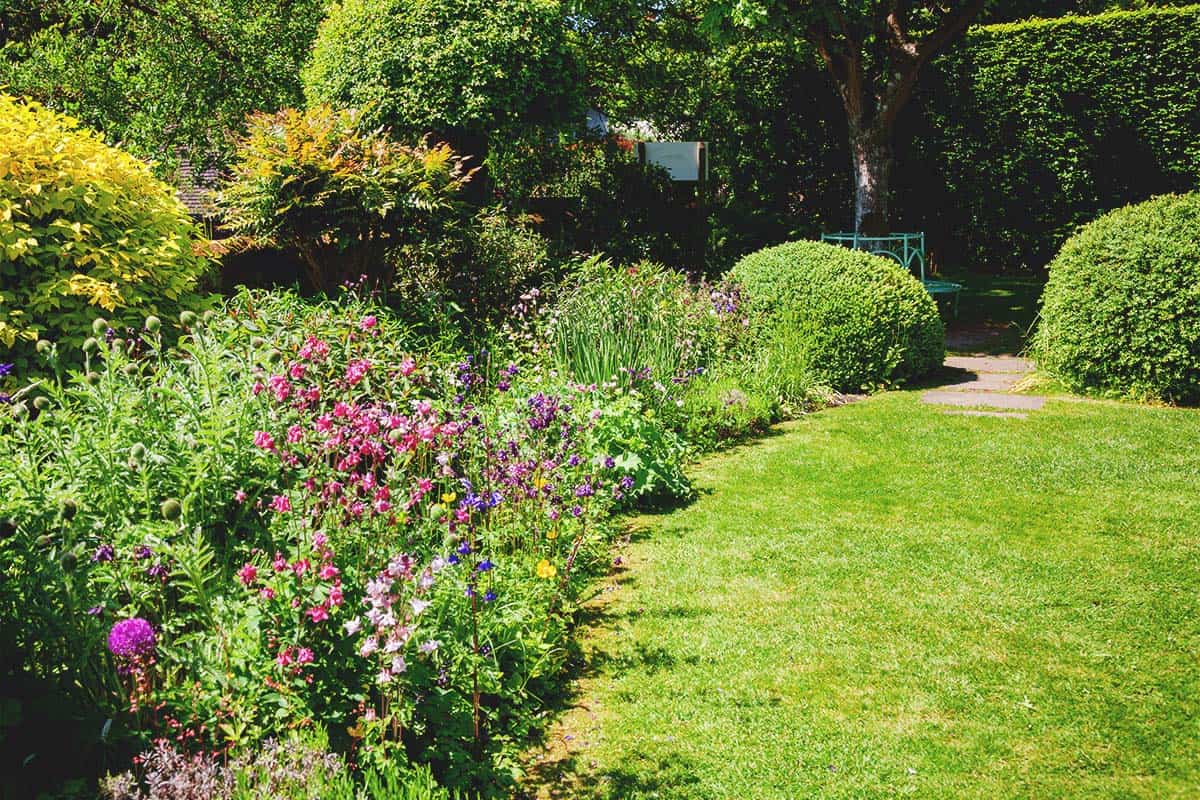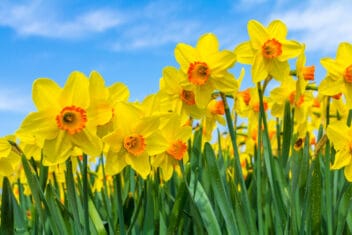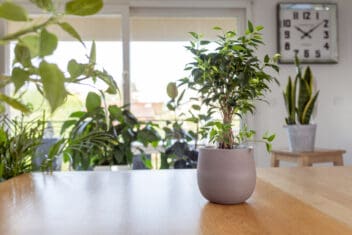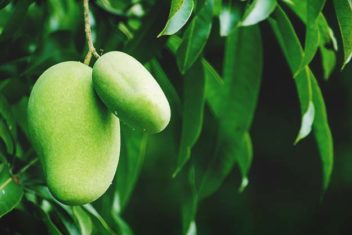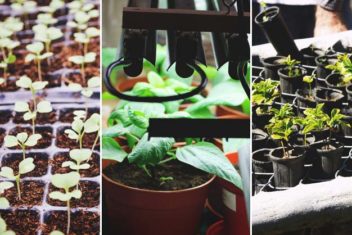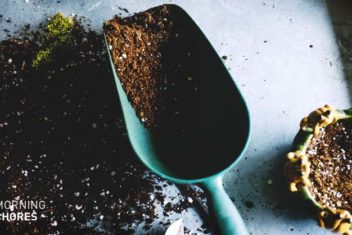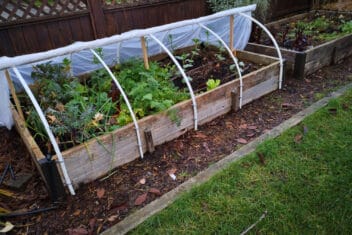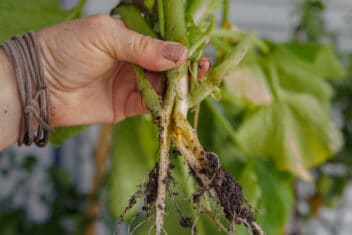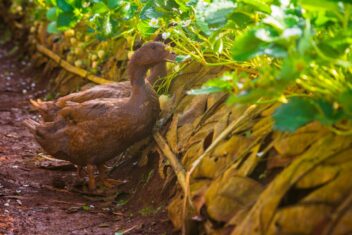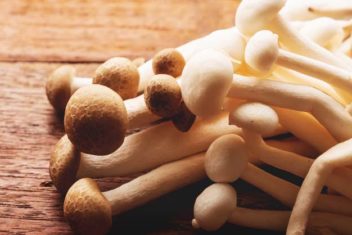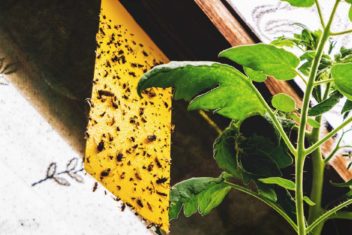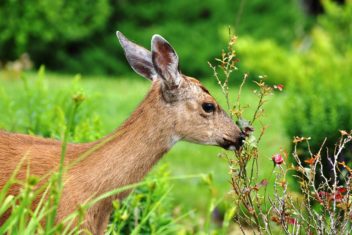Hedges have been grown for at least 6000 years. In fact, the earliest hedges were probably used on farms and homesteads. They were originally implemented to mark property lines, confine animals, divide crop fields, and act as windbreaks. Plus, in times of turmoil, they were used to slow down foreign invasions.
Then, in the 16th and 17th centuries, hedges got a makeover. Rather than serving purely functional purposes, they were made into sculptures to create intricate patterns, walkways, and labyrinths. They were often meant to be viewed as works of living art.
Today, hedges are everywhere. You see them lining parking lots of strip malls, in suburban front yards, and in botanical gardens. Usually, they are made with boxwoods, privet, arborvitae, or other small-leaved evergreens. Sometimes they are heavily pruned for uniformity, other times they are a bit wild and bush-like.
Personally, although I love the look of hedges, the idea of tending to plants that are purely decorative seems absurd. As a homesteader, I don’t have time for that! So, instead, my hedges are edible, medicinal, useful for livestock, support the biodiversity of wildlife, or deter pests.
If you also want to put hedges to good use on your homestead, read on for inspiration, and plant ideas to increase the productivity of your homestead while adding beauty!

Homesteading Hedges to Create Boundaries
Hedges can help mark boundaries such as between different garden areas. For example, many farmers will grow what’s often called a hedgerow, or a mix of trees and shrubs, between crop fields. You can also use these to mark property lines when you have lots of acreages.
1. Fruit and Nut Hedges
Fruit and nut trees or shrubs can be great options for boundaries. Pecans, walnuts, butternut, or chestnuts are great as tall markers in large landscapes.
Standard-sized disease-resistant apples, Asian pears, and persimmons are good low-maintenance tall fruit tree options. For multi-stemmed bush type options, Aronia berries and hazelnuts are great harvestable food sources.
2. Fodder and Craft Hedges
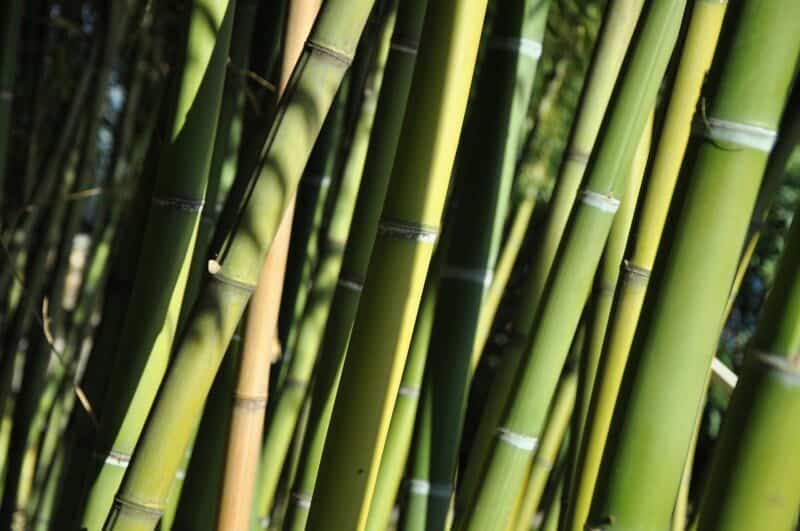
Willow is also a classic boundary choice. You can harvest the excess for livestock fodder and homestead craft projects.
Bamboo makes a wonderful tall boundary hedge. Plus you can eat the shoots and harvest the bamboo for garden, craft, and building projects. Goats also love to eat the leaves.
Practical Hedges as a Pollination Barrier
You may also want to use thickly planted hedges as pollination barriers. The size and type of your pollination barrier will depend on how likely your plants are to cross-pollinate.
For example, self-fertile plants, or plants that are pollinator specific, won’t need as large of a hedged area as plants that easily cross-pollinate by wind pollination.
Here are a few pollination hedge ideas to consider.
3. Flavor Savers

Even though pepper plants are self-fertile, it is quite common for cross-pollination to affect the seed flavor. Sweet peppers can end up tasting hot when grown too close to hot peppers. Or your jalapenos might be less piquant if pollen gets muddled with bell peppers.
So, give those plants as much physical distance as you can. Then divide them by a hot season hedge of flowering annuals like basil grown for edible flowers or buckwheat.
4. Seed Savers
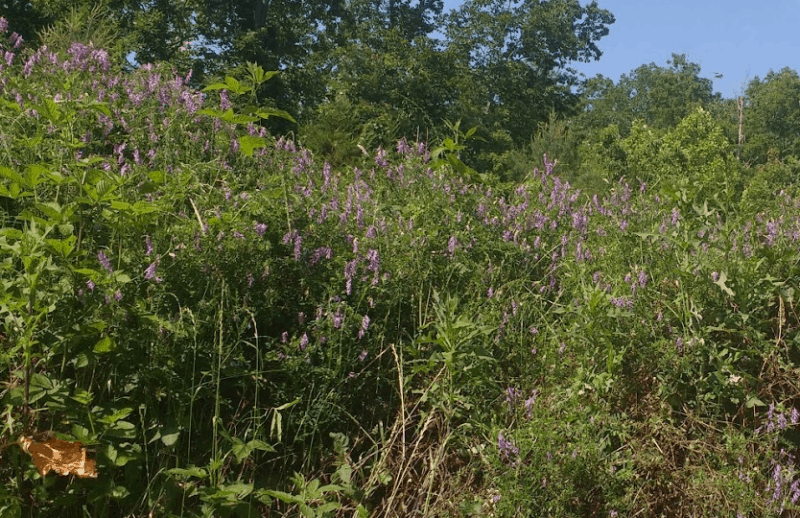
If you are trying to save seeds for future use, you need a lot of space between plants. Plus you can also plant a thicket type hedge to catch pollen carried on the wind and by longer ranging insects.
I often stake heavily planted hairy vetch as a kind of pollen net. The hairy vetch can grow 6-7 feet tall and will vine all over random sticks and stakes to create a thick blanket of foliage.
Protective Hedges for Pest Reduction
Strongly scented or potentially toxic hedges offer some protection from pests.
5. Toxic Nightshades
People with intense deer or rabbit pressure will tell you there’s no such thing as deer-resistant plants. They’ve even been known to eat tomatoes or potato tops which are supposedly toxic. Yet, in situations when food for those critters is plentiful, plant hedges can offer some protection for more palatable plants.
For example, planting a potato hedge around your lettuce bed can confuse garden pests. Planting a row of tomatoes around your garden perimeter can slow down unwanted garden guests. Because these plants are in the nightshade family, their leaves contain solanine which can be toxic to all sorts of mammals.
6. Fragrant Distractions
Plants like strong mints, marigolds, chives, garlic, and lavender contain aromas that are less than appetizing to voles, rabbits, deer, and other possible garden pests. For these to be effective deterrents, you must plant them densely in a hedge and make sure those critters have to pass through them to get to your plants.
The critters will disturb the plants and release the aromas while trying to get to tastier treats. That will slow them down and make them think twice before crossing those fragrant hedges in the future.
These kinds of plants may also provide a little bit of protection against insect pests. But for that to be effective, you’ll want to damage the leaves often to release the aroma.
Pretty Hedges to Provide Privacy
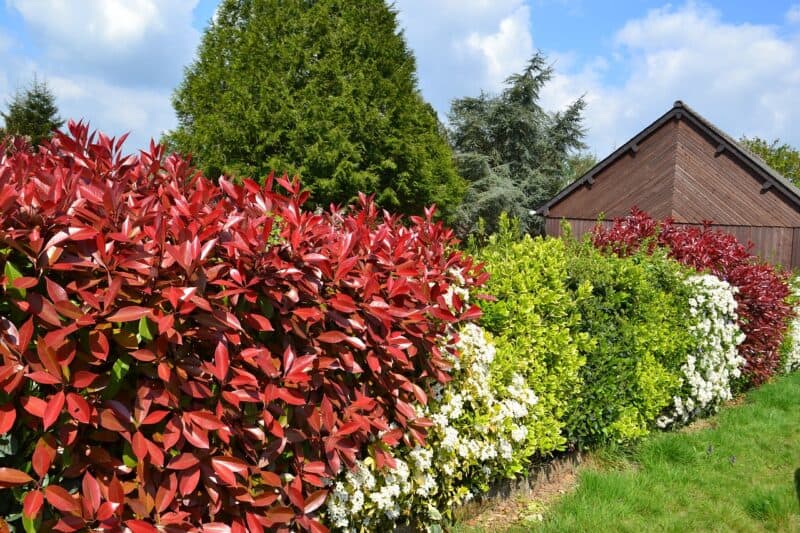
Hedges can also be used to create privacy.
7. Mammoth Sunflowers
A line of Mammoth sunflowers around your outdoor eating areas is a great way to surround yourself with beautiful flowers, grow extra food for you or your livestock, and keep your neighbors from desiring all the delicious dishes you create fresh from your garden.
Just keep in mind that some cities, towns, or homeowner associations may have rules against making privacy hedges. So, make sure to check with whichever organization regulates your use of your yard before investing in new plants.
8. Jerusalem Artichoke
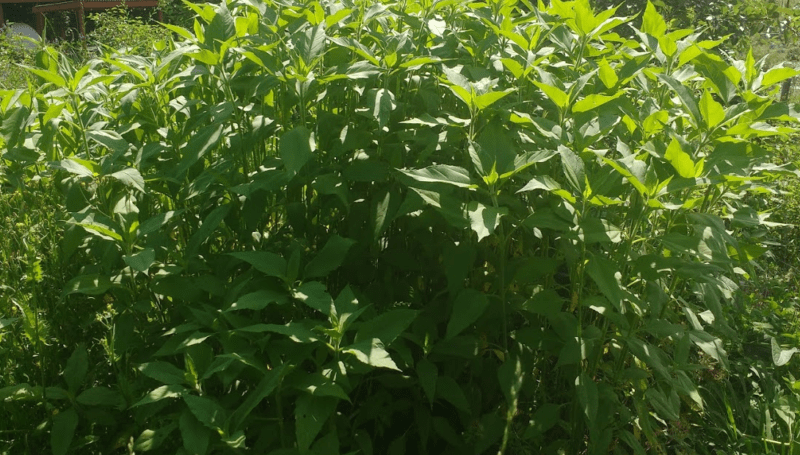
Similar to mammoth sunflowers, Jerusalem artichoke grows 10-12 feet tall during the summer months and is covered with small sunflower-like flowers in September and October. Then, after a light frost or two, you can harvest their tubers which have the crunch of an apple with the taste of an herby potato.
Those plants work best along a fence or with staking. Also, in order to use them as a dense hedge, you will need to plant them in deep soil and use fertilizer so they don’t look spindly and become disease-prone.
I personally love to grow these around my chicken fences to hide the brown scratched earth. The chicken manure that saturates the soil in that area provides plenty of fertility for the plants.
Provisional Hedges for Biodiversity
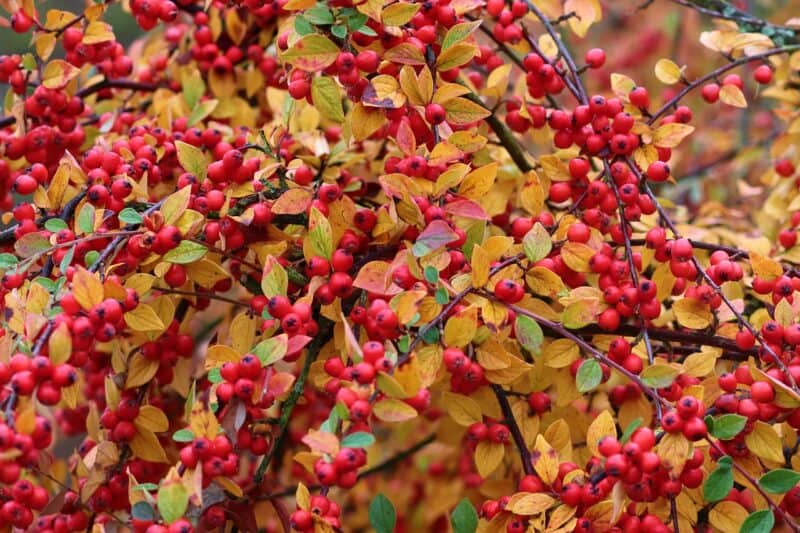
In my opinion, no homestead is complete unless you have a diversity of wildlife along with all your intentional livestock. Without that, you’ll deal with lots more pest problems, have fewer crops due to pollination issues, and end up spending more to feed your chickens and ducks without all that free insect food flying around.
Here are some great biodiversity encouraging hedge plants.
9. Mulberry
Mulberry is a fast-growing tree or shrub that makes delicious berries. Its leaves are loved by silkworms and other caterpillars. Plus, your goats will love it too.
It’s extremely low maintenance and highly productive. Plant them along your duck run to offer shade and free food to your ducks while also drawing more insects and wildlife to the area.
10. Elderberry
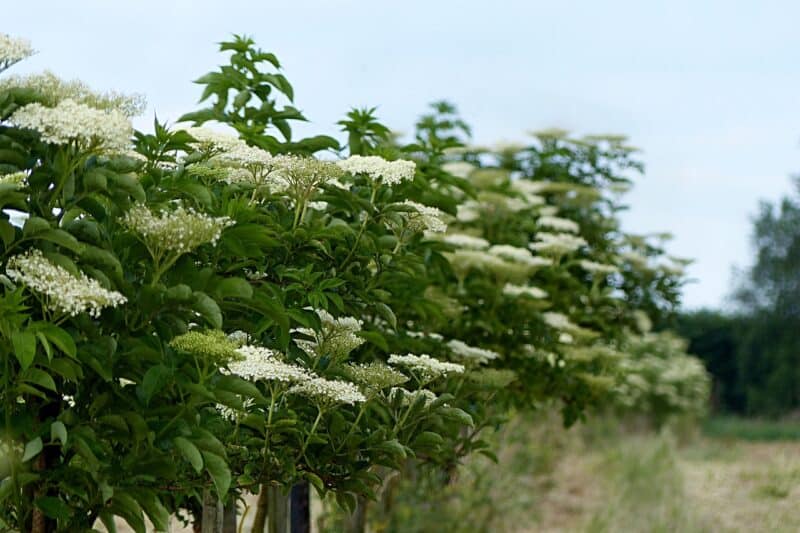
Elderberry is another great option for a fast-growing hedge that supports wildlife and livestock. My ducks practically live under our elderberry hedges on hot days. They eat the berries as they ripen. More importantly, they eat the multitude of grasshoppers that flock to the leaves of these plants.
11. Sumac
Sumacs that start with “Rhus” in the Latin name (not the poisonous kind) are shrubby trees that grow by underground rhizome runners. The flowers are pollinator favorites. Plus the leaves are great for compost piles and as livestock fodder. Some varieties even have edible pericarps that make a great spice.
When grown densely together, older plants stay short and young plants act as an understory for tall plants. These are great to use as a hedge in areas where not much else will grow.
Smart Hedges to Add Functional Beauty
My favorite reason for growing hedges, though, is to add functional beauty. When you live on a working homestead full of livestock and a constant succession of ever-changing crops, hedges can provide constant beauty throughout the seasons.
12. Lemon Balm
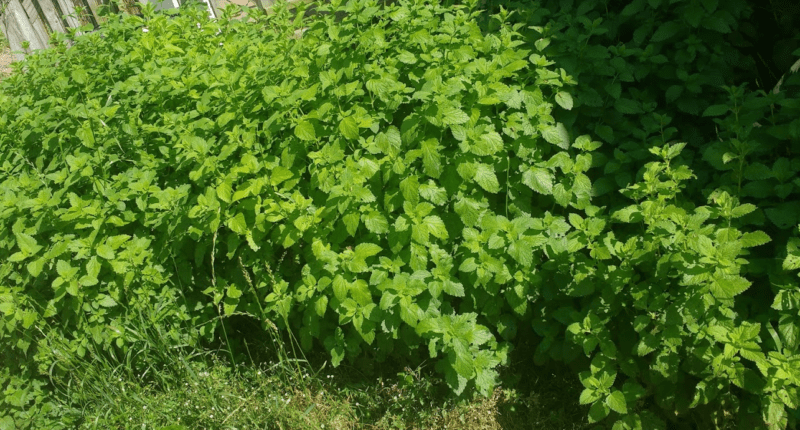
By growing what you already plan to plant in groups as hedges, you can create aesthetic impact without wasting space. For example, I grow lemon balm for teas, to make insect repellent, and to use as mulch under other plants such as cabbage to discourage insect pests.
It’s a pretty plant all by itself. But when I grow it in rows around my fruit trees or along walkways, it makes underutilized areas seem more intentional and orderly in appearance.
13. Common Plantain

Plantain is often mistaken for a weed because it grows so well in areas where other plants don’t thrive. When it appears in less than ideal conditions such as compacted soil or heavy shade, it’s a tiny, pathetic little plant without much beauty.
Yet, when you actually give it dedicated space in good conditions, it’s every bit as beautiful as other medicinal herbs. You can even mow it several times per year to keep it from flowering and spreading.
Plantain is wonderful for stopping the itch of insect bites and used in homemade skincare products. Personally, I use it for making teas that help reduce my asthma symptoms. Since my ducks don’t eat it, I grow it as a hedge along the pathways to my pond. It adds beauty while preventing erosion in areas that ducks might otherwise damage.
Fragrant Hedges to Cultivate Spices
I grow a lot of spice plants as hedges. In fact, I grow so many that I even wrote a book called Grow Your Own Spices (Available December 2020) to help other people grow their own at home.
Spices are stunningly beautiful when grown as hedges. Here are a few of my favorites.
14. Mustard

Mustard grown for seeds can be used to make condiments and to add to curries. The plants start out as leafy bushes that are just a couple of feet tall. But when they seed, they grow to 5-6 feet tall in my garden.
I grow it in beds around the outside of my garden so they look like large intentional hedges. When the seeds have formed, but still need more time to dry before harvest, I tie the plants together to make them look like seed trees.
15. Coriander
Coriander is another spice that makes a lovely hedge. I usually make about a two-foot-wide hedge from my coriander. Their delicate white lace flowers are stunning and fragrant. As such, they are lovely around outdoor eating areas.
16. Poppies
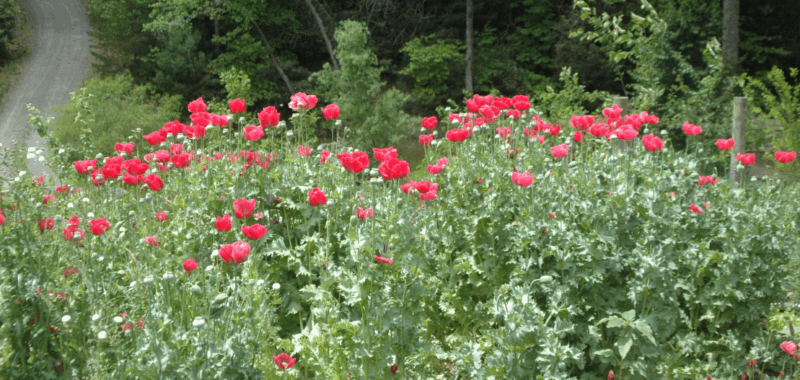
Breadseed poppy flowers are another favorite for hedges. You do need to make sure you can legally grow breadseed poppies where you live.
If you can, they grow about 3-5 feet tall, depending on the variety. The huge seed pod heads get more beautiful as they dry. Just make sure to cut the seed heads before the vents open or you’ll lose your crop and have a poppy invasion in future years.
17. Sesame
Sesame is also a stunning spice plant that looks a lot like a leafy okra. It can get 4-6 feet tall depending on the variety and is a pollinator favorite. It does require a long hot season, or to be started indoors. But it can stand as a hedge for 120 days or all of your growing season.
Homesteading Hedges For Year-Round Interest
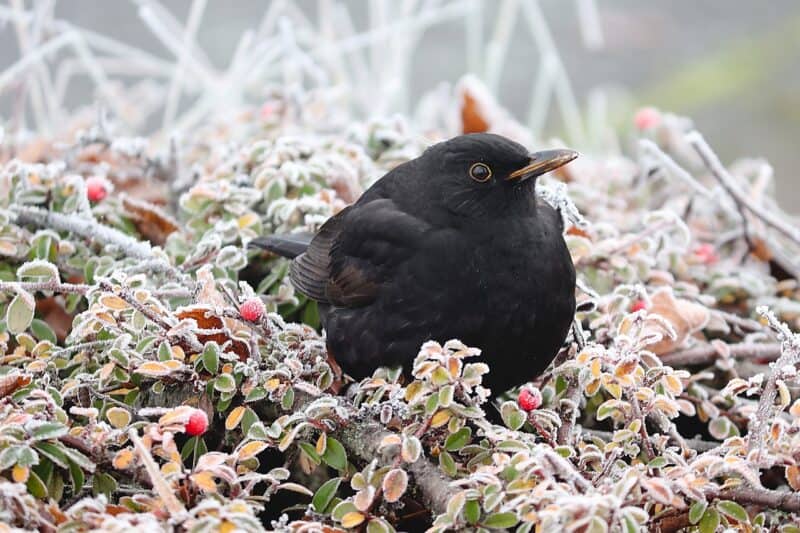
Most of the hedges I’ve listed are prettiest in the growing season. But here are some that are lovely year-round.
18. Bay Laurel
If you live in a USDA zone 8 or up, then Bay Laurel makes a great option for an evergreen hedge. You can prune it to keep it shrubby or train it as a topiary. These plants can get to 30 feet without pruning but can be kept to under 10 feet with regular pruning.
19. Roses
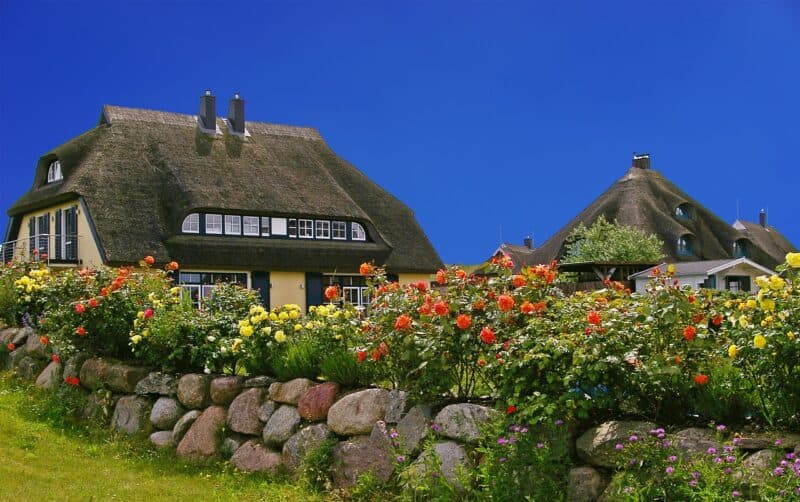
Rose petals are wonderful to use for making fancy confitures, teas, and flavoring deserts. The kinds that produce rosehips are also wonderful for teas and as a vitamin C supply on the homestead. Also, many of the rosehip varieties make wonderful hedges.
For example, I have a small hedge of Rosa rugosa started around one of my fruit tree areas. These lovely shrubs grow outward in clumps and form a dense line of thorned stems.
They do lose their leaves in winter, but the hairy stems are even protective and interesting to see in winter. This shrubby rose, and others like it, grow well in zones 2-7.
20. Goji Berry
Goji berry plants, in good soil, will grow an abundance of stems that can either be pruned for tidiness or left wild to form a weeping habit. You’ll get more fruit if you prune heavily. But if you want to use them as a thick hedge even minimally pruned shrubs will give you a harvest.
These plants put out a lot of suckers. So, you can easily use that habit to create a tight hedge. However, you will have to create a barrier to keep them from spreading into other areas. Or stay on top of pulling the runners before they establish.
Depending on variety, I’ve read that these can grow in Zones 3-9. They grow extremely well where I live in zone 7a.
You will need to winter prune them since fruit grows on new growth. But you can wait until just before they leaf to do it.
21. Rosemary
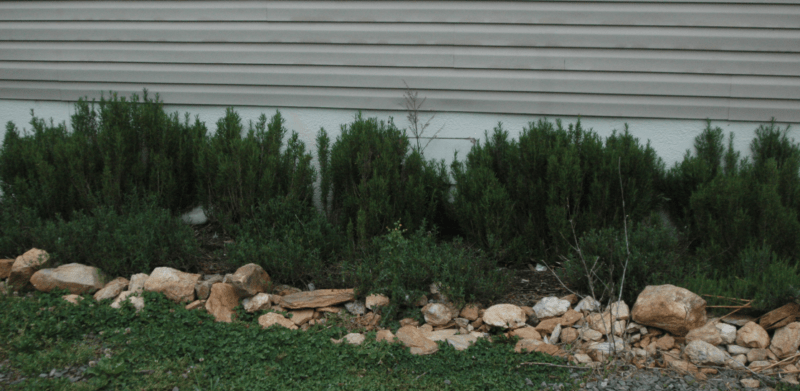
Rosemary is a great option for a short hedge for gardeners in zones 5 or up. Keep in mind that most rosemary varieties are only cold hard to zone 7B or above. So, you will need to find rosemary varieties that are specifically suited to colder conditions in zone 5-7a.
22. Hyssop
Another gorgeous option for a low hedge is true hyssop (Hyssopus officinalis). This lovely plant is valued for its medicinally potent flower stakes. However, people who love strong herby tastes (like me) also use the cut stems and leaves in cooking.
Its electric purple flowers and low mounding habit make it great for walkway hedges. If you create a bit of a microclimate by keeping it out of windy areas and lining it with dark rocks or gravel, and mulching it in winter, it may even be cold hardy down to USDA zones 3-4.
Final Advice for Homesteading Hedges
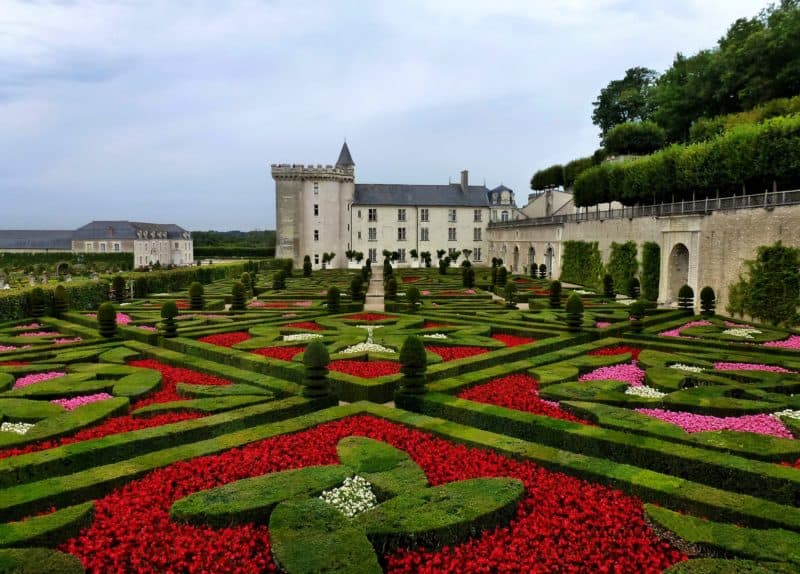
There are so many amazing plants that grow well in hedges. What you use and how you use it will depend on your climate, needs, available space, and aesthetic preferences.
Do keep in mind though that mono-cropping (planting large areas of one crop) promotes more pests, increases pathogen risks, and quickly depletes the soil. So, rather than selecting just one kind of plant for all your homestead hedges, mix and match throughout your landscape to increase plant diversity.
I keep my hedges to about 8 feet long, per plant type. Then if I need a longer hedge, I’ll switch to a different plant that meets my needs. For example, I might plant 8 feet of sunflowers, followed by 8 feet of corn, then 8 feet of sesame to create a 24-foot edible summer hedge.
May all your edges be beautified by hedges!
